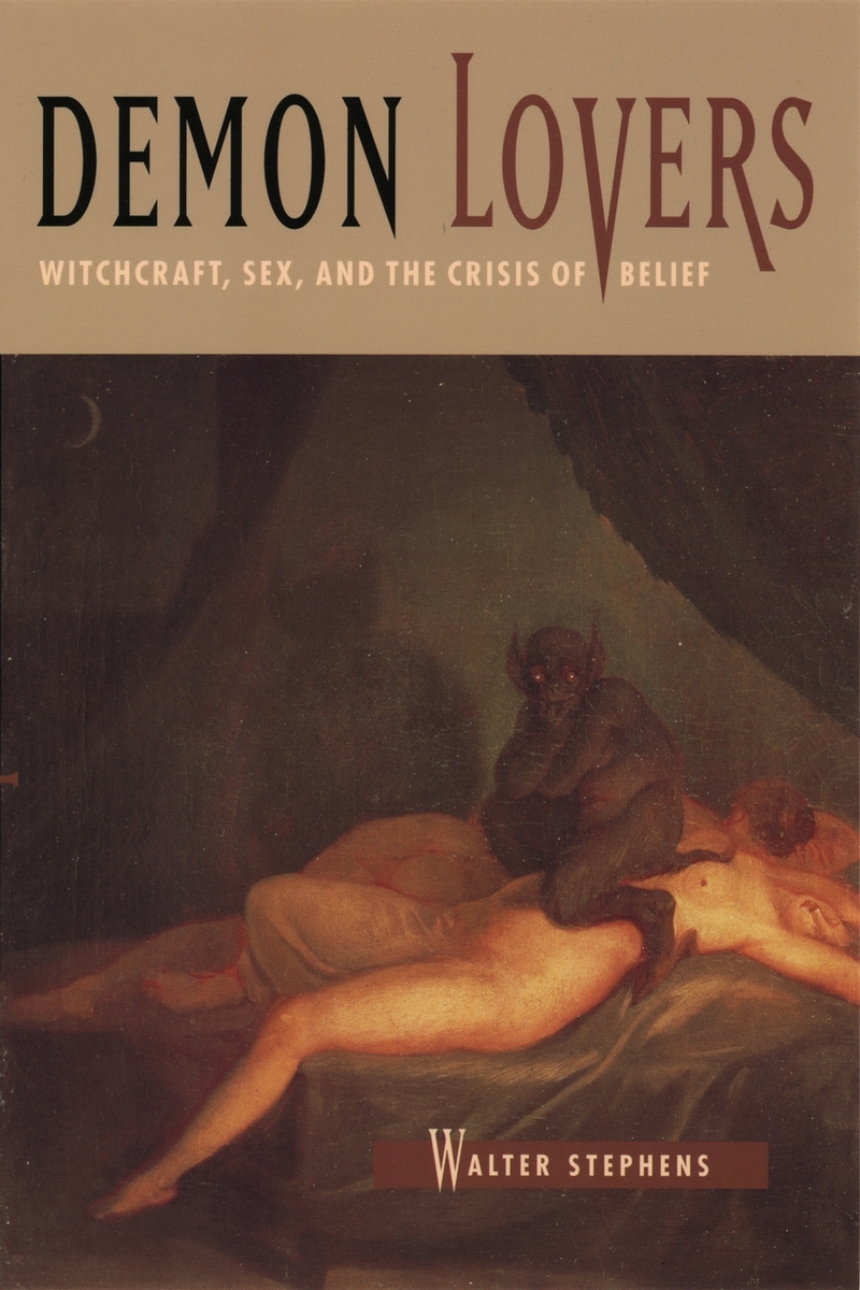Demon Lovers
Witchcraft, Sex, and the Crisis of Belief
On September 20, 1587, Walpurga Hausmännin of Dillingen in southern Germany was burned at the stake as a witch. Although she had confessed to committing a long list of maleficia (deeds of harmful magic), including killing forty—one infants and two mothers in labor, her evil career allegedly began with just one heinous act—sex with a demon. Fornication with demons was a major theme of her trial record, which detailed an almost continuous orgy of sexual excess with her diabolical paramour Federlin "in many divers places, . . . even in the street by night."
As Walter Stephens demonstrates in Demon Lovers, it was not Hausmännin or other so-called witches who were obsessive about sex with demons—instead, a number of devout Christians, including trained theologians, displayed an uncanny preoccupation with the topic during the centuries of the "witch craze." Why? To find out, Stephens conducts a detailed investigation of the first and most influential treatises on witchcraft (written between 1430 and 1530), including the infamous Malleus Maleficarum (Hammer of Witches).
Far from being credulous fools or mindless misogynists, early writers on witchcraft emerge in Stephens’s account as rational but reluctant skeptics, trying desperately to resolve contradictions in Christian thought on God, spirits, and sacraments that had bedeviled theologians for centuries. Proof of the physical existence of demons—for instance, through evidence of their intercourse with mortal witches—would provide strong evidence for the reality of the supernatural, the truth of the Bible, and the existence of God. Early modern witchcraft theory reflected a crisis of belief—a crisis that continues to be expressed today in popular debates over angels, Satanic ritual child abuse, and alien abduction.
As Walter Stephens demonstrates in Demon Lovers, it was not Hausmännin or other so-called witches who were obsessive about sex with demons—instead, a number of devout Christians, including trained theologians, displayed an uncanny preoccupation with the topic during the centuries of the "witch craze." Why? To find out, Stephens conducts a detailed investigation of the first and most influential treatises on witchcraft (written between 1430 and 1530), including the infamous Malleus Maleficarum (Hammer of Witches).
Far from being credulous fools or mindless misogynists, early writers on witchcraft emerge in Stephens’s account as rational but reluctant skeptics, trying desperately to resolve contradictions in Christian thought on God, spirits, and sacraments that had bedeviled theologians for centuries. Proof of the physical existence of demons—for instance, through evidence of their intercourse with mortal witches—would provide strong evidence for the reality of the supernatural, the truth of the Bible, and the existence of God. Early modern witchcraft theory reflected a crisis of belief—a crisis that continues to be expressed today in popular debates over angels, Satanic ritual child abuse, and alien abduction.
478 pages | 16 halftones, 2 diagrams | 6 x 9 | © 2003
History: European History
Literature and Literary Criticism: Romance Languages
Religion: Christianity, Religion and Society
Reviews
Table of Contents
List of Illustrations
Acknowledgments
Note on Translations
Introduction: Sex Fiends
1. Witchcraft Theory: Copulation with Demons as Carnal Knowledge
2. Why Women? The Malleus maleficarum
3. Sexy Devils: How They Got Bodies
4. Incredible Sex: Confronting the Difficulty of Belief
5. From Dreams to Reality: Why Witches Fly
6. Experiments with Witches
7. The Theory of Witchcraft Power
8. "This Is My Body": Witches and Desecration
9. Witches, Infanticide, and Power
10. Illusion and Reality, Part One: Crib Death and Stealthy Cats
11. Illusion and Reality, Part Two: Witches Who Steal Penises
12. Interview with the Demon: From Exorcism to Witchcraft
13. Witchcraft, Body, and Soul
Conclusion: Talking around the Unspeakable
Notes
Works Cited
Index
Acknowledgments
Note on Translations
Introduction: Sex Fiends
1. Witchcraft Theory: Copulation with Demons as Carnal Knowledge
2. Why Women? The Malleus maleficarum
3. Sexy Devils: How They Got Bodies
4. Incredible Sex: Confronting the Difficulty of Belief
5. From Dreams to Reality: Why Witches Fly
6. Experiments with Witches
7. The Theory of Witchcraft Power
8. "This Is My Body": Witches and Desecration
9. Witches, Infanticide, and Power
10. Illusion and Reality, Part One: Crib Death and Stealthy Cats
11. Illusion and Reality, Part Two: Witches Who Steal Penises
12. Interview with the Demon: From Exorcism to Witchcraft
13. Witchcraft, Body, and Soul
Conclusion: Talking around the Unspeakable
Notes
Works Cited
Index
Awards
American Academy of Religion: American Academy of Religion Awards for Excellence
Shortlist
